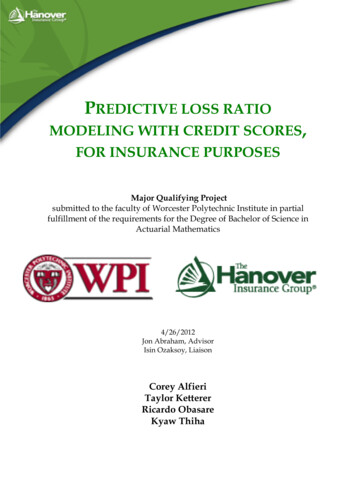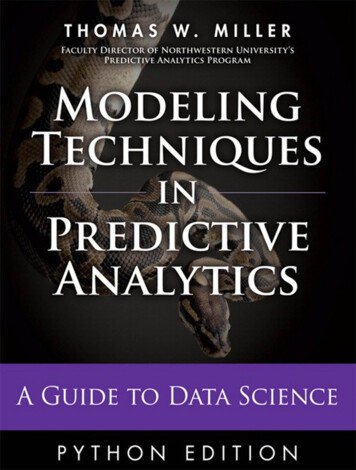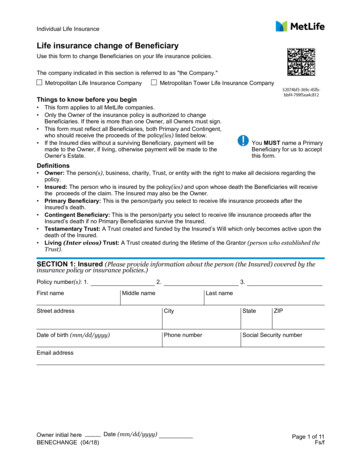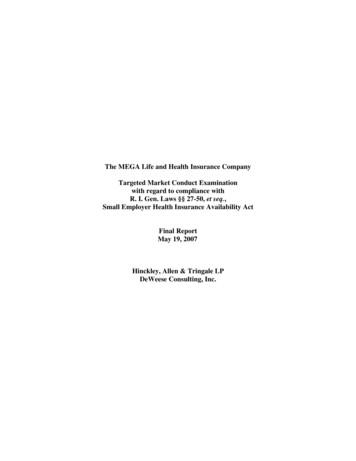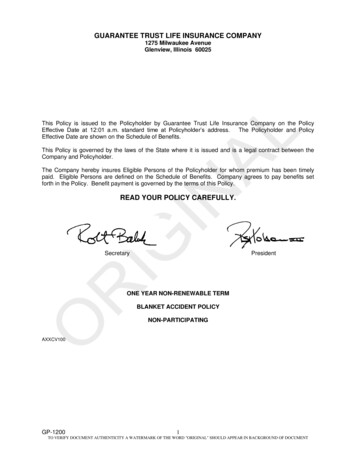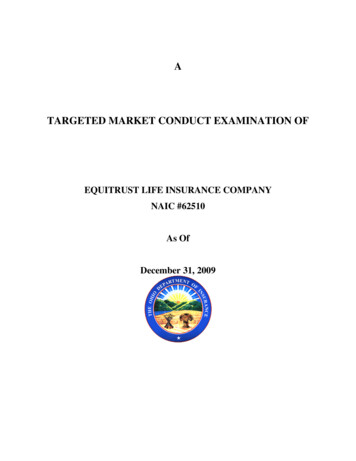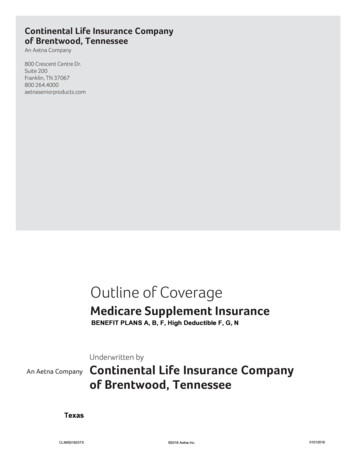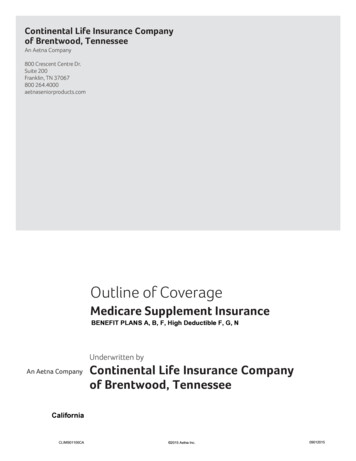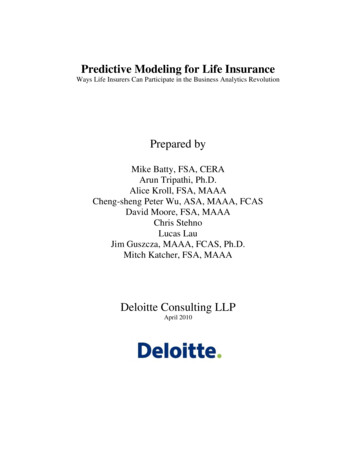
Transcription
Predictive Modeling for Life InsuranceWays Life Insurers Can Participate in the Business Analytics RevolutionPrepared byMike Batty, FSA, CERAArun Tripathi, Ph.D.Alice Kroll, FSA, MAAACheng-sheng Peter Wu, ASA, MAAA, FCASDavid Moore, FSA, MAAAChris StehnoLucas LauJim Guszcza, MAAA, FCAS, Ph.D.Mitch Katcher, FSA, MAAADeloitte Consulting LLPApril 2010
Predictive Modeling for Life InsuranceWays Life Insurers Can Participate in the Business Analytics RevolutionAbstractThe use of advanced data mining techniques to improve decision making has already taken root inproperty and casualty insurance as well as in many other industries [1, 2]. However, the application ofsuch techniques for more objective, consistent and optimal decision making in the life insuranceindustry is still in a nascent stage. This article will describe ways data mining and multivariate analyticstechniques can be used to improve decision making processes in such functions as life insuranceunderwriting and marketing, resulting in more profitable and efficient operations. Case studies willillustrate the general processes that can be used to implement predictive modeling in life insuranceunderwriting and marketing. These case studies will also demonstrate the segmentation power ofpredictive modeling and resulting business benefits.Keywords: Predictive Modeling, Data Mining, Analytics, Business Intelligence, Life Insurance PredictiveModeling2
Predictive Modeling for Life InsuranceWays Life Insurers Can Participate in the Business Analytics RevolutionContentsThe Rise of “Analytic” Decision Making. 4Current State of Life Insurance Predictive Modeling. 6Business Application that Can Help Deliver a Competitive Advantage. 10Life Underwriting . 10Marketing. 14In-force Management. 15Additional Predictive Model Applications . 16Building a Predictive Model . 17Data . 17Modeling Process. 19Monitoring Results . 24Legal and Ethical Concerns. 24The Future of Life Insurance Predictive Modeling . 263
Predictive Modeling for Life InsuranceWays Life Insurers Can Participate in the Business Analytics RevolutionThe Rise of “Analytic” Decision MakingPredictive modeling can be defined as the analysis of large data sets to make inferences or identifymeaningful relationships, and the use of these relationships to better predict future events [1,2]. It usesstatistical tools to separate systematic patterns from random noise, and turns this information intobusiness rules, which should lead to better decision making. In a sense, this is a discipline that actuarieshave practiced for quite a long time. Indeed, one of the oldest examples of statistical analysis guidingbusiness decisions is the use of mortality tables to price annuities and life insurance policies (whichoriginated in the work of John Graunt and Edmund Halley in the 17th century). Likewise, throughoutmuch of the 20th century, general insurance actuaries have either implicitly or explicitly usedGeneralized Linear Models [3,4,5] and Empirical Bayes (a.k.a. credibility) techniques [6,7] for the pricingof short-term insurance policies. Therefore, predictive models are in a sense, “old news.” Yet in recentyears, the power of statistical analysis for solving business problems and improving business processeshas entered popular consciousness and become a fixture in the business press. “Analytics,” as the fieldhas come to be known, now takes on a striking variety of forms in an impressive array of business andother domains.Credit scoring is the classic example of predictive modeling in the modern sense of “business analytics.”Credit scores were initially developed to more accurately and economically underwrite and determineinterest rates for home loans. Personal auto and home insurers subsequently began using credit scoresto improve their selection and pricing of personal auto and home risks [8,9]. It is worth noting that oneof the more significant analytical innovations in personal property-casualty insurance in recent decadesoriginated outside the actuarial disciplines. Still more recently, U.S. insurers have widely adoptedscoring models – often containing commercial credit information – for pricing and underwriting complexand heterogeneous commercial insurance risks [10].The use of credit and other scoring models represents a subtle shift in actuarial practice. This shift hastwo related aspects. First, credit data is behavioral in nature and, unlike most traditional ratingvariables, bears no direct causal relationship to insurance losses. Rather, it most likely serves as a proxymeasure for non-observable, latent variables such as “risk-seeking temperament” or “carefulpersonality” that are not captured by more traditional insurance rating dimensions. From here it is anatural leap to consider other sources of external information, such as lifestyle, purchasing, household,social network, and environmental data, likely to be useful for making actuarial predictions [11, 24].Second, the use of credit and other scoring models has served as an early example of a widening domainfor predictive models in insurance. It is certainly natural for actuaries to employ modern analytical andpredictive modeling techniques to arrive at better solutions to traditional actuarial problems such asestimating mortality, setting loss reserves, and establishing classification ratemaking schemes. But4
actuaries and other insurance analytics are increasingly using predictive modeling techniques to improvebusiness processes that traditionally have been largely in the purview of human experts.For example, the classification ratemaking paradigm for pricing insurance is of limited applicability forthe pricing of commercial insurance policies. Commercial insurance pricing has traditionally been drivenmore by underwriting judgment than by actuarial data analysis. This is because commercial policies arefew in number relative to personal insurance policies, are more heterogeneous, and are described byfewer straightforward rating dimensions. Here, the scoring model paradigm is especially useful. Inrecent years it has become common for scoring models containing a large number of commercial creditand non-credit variables to ground the underwriting and pricing process more in actuarial analysis ofdata, and less in the vagaries of expert judgment. To be sure, expert underwriters remain integral to theprocess, but scoring models replace the blunt instrument of table- and judgment-driven credits anddebits with the precision tool of modeled conditional expectations.Similarly, insurers have begun to turn to predictive models for scientific guidance of expert decisions inareas such as claims management, fraud detection, premium audit, target marketing, cross-selling, andagency recruiting and placement. In short, the modern paradigm of predictive modeling has madepossible a broadening, as well as a deepening, of actuarial work.As in actuarial science, so in the larger worlds of business, education, medicine, sports, andentertainment. Predictive modeling techniques have been effective in a strikingly diverse array ofapplications such as:Predicting criminal recidivism [12]Making psychological diagnoses [12]Helping emergency room physicians more effectively triage patients [13]Selecting players for professional sports teams [14]Forecasting the auction price of Bordeaux wine vintages [15]Estimating the walk-away “pain points” of gamblers at Las Vegas casinos to guide casinopersonnel who intervene with free meal coupons [15]Forecasting the box office returns of Hollywood movies [16]A common theme runs through both these and the above insurance applications of predictive modeling.Namely, in each case predictive models have been effective in domains traditionally thought to be in thesole purview of human experts. Such findings are often met with surprise and even disbelief.Psychologists, emergency room physicians, wine critics, baseball scouts, and indeed insuranceunderwriters are often and understandably surprised at the seemingly uncanny power of predictivemodels to outperform unaided expert judgment. Nevertheless, substantial academic research,predating the recent enthusiasm for business analytics by many decades, underpins these findings. PaulMeehl, the seminal figure in the study of statistical versus clinical prediction, summed up his life’s workthus [17]:5
There is no controversy in social science which shows such a large body of quantitativelydiverse studies coming out so uniformly in the same direction as this one. When youare pushing over 100 investigations, predicting everything from the outcome of footballgames to the diagnosis of liver disease, and when you can hardly come up with half adozen studies showing even a weak tendency in favor of the clinician, it is time to drawa practical conclusion.Certainly not all applications of predictive modeling have a “clinical versus actuarial judgment” character[18]. For example, amazon.com and netflix.com make book and movie recommendations without anyhuman intervention [25]. Similarly, the elasticity-optimized pricing of personal auto insurance policiescan be completely automated (barring regulatory restrictions) through the use of statistical algorithms.Applications such as these are clearly in the domain of machine, rather than human, learning. However,when seeking out ways to improve business processes, it is important to be cognizant of the oftensurprising ability of predictive models to improve judgment-driven decision-making.Current State of Life Insurance Predictive ModelingWhile life insurers are noted among the early users of statistics and data analysis, they are absent fromthe above list of businesses where statistical algorithms have been used to improve expert-drivendecisions processes. Still, early applications of predictive modeling in life insurance are beginning tobear fruit, and we foresee a robust future in the industry [19].Life insurance buffers society from the full effects of our uncertain mortality. Firms compete with eachother in part based on their ability to replace that uncertainty with (in aggregate) remarkably accurateestimates of life expectancy. Years of fine-tuning these estimates have resulted in actuarial tables thatmirror aggregate insured population mortality, while underwriting techniques assess the relative risk ofan individual. These methods produce relatively reliable risk selection, and as a result have beenaccepted in broadly similar fashion across the industry. Nonetheless, standard life insuranceunderwriting techniques are still quite costly and time consuming. A life insurer will typically spendapproximately one month and several hundred dollars underwriting each applicant1.Many marginal improvements to the underwriting process have taken hold: simplified applications forsmaller face amounts, refinement of underwriting requirements based upon protective value studies,and streamlined data processing via automated software packages are all examples. However, theexamples in the previous section suggest that property-casualty insurers have gone farther indeveloping analytics-based approaches to underwriting that make better use of available information toyield more accurate, consistent, and efficient decision-making. Based on our experience, life insuranceunderwriting is also ripe for this revolution in business intelligence and predictive analytics. Perhaps1According to the Deloitte 2008 LIONS benchmarking study of 15 life insurers, the median service time to issue anew policy ranges between 30 and 35 days for policies with face amounts between 100k to 5 million, and theaverage cost of requirements (excluding underwriter time) is 130 per applicant.As used in this document, “Deloitte” means Deloitte Consulting LLP, a subsidiary of Deloitte LLP. Please seewww.deloitte.com/us/about for a detailed description of the legal structure of Deloitte LLP and its subsidiaries.6
motivated by the success of analytics in other industries, life insurers are now beginning to explore thepossibilities2.Despite our enthusiasm, we recognize that life underwriting presents its own unique set of modelingchallenges which have made it a less obvious candidate for predictive analytics. To illustrate thesechallenges it is useful to compare auto underwriting, where predictive modeling has achievedremarkable success, with life underwriting, where modeling is a recent entry. Imagine everything aninsurer could learn about a prospective customer: age, type of car, accident history, credit history,geographic location, personal and family medical history, behavioral risk factors, and so on. A predictivemodel provides a mapping of all these factors combine onto the expected cost of insuring the customer.Producing this map has several prerequisites:A clearly defined target variable, i.e. what the model is trying to predictThe availability of a suitably rich data set, in which at least some predictive variables correlatedwith the target can be identifiedA large number of observations upon which to build the model, allowing the abidingrelationships to surface and be separated from random noiseAn application by which model results are translated into business actionsWhile these requirements are satisfied with relative ease in our auto insurance example, life insurersmay struggle with several of them.Auto InsurerTargetVariableModelingDataFrequencyof LossBusinessActionUnderwriting requirements supplementedby third-party dataApproximately 10 percent of drivers makeclaims annuallyLife InsurerMortality experience over life of product(10, 20 years)Underwriting requirements supplementedby third-party dataTypically, fewer than 1 first year death per1,000 new policies issuedUnderwriting DecisionUnderwriting DecisionClaims over six-month contractStatisticians in either domain can use underwriting requirements, which are selected based upon theirassociation with insurance risk, supplement them with additional external data sources, and developpredictive models that will inform their underwriting decisions. However, the target variable andvolume of data required for life insurance models raise practical concerns.For the auto insurer, the amount of insurance loss over the six-month contract is an obvious candidatefor a model’s target variable. But because most life insurance is sold through long duration contracts,the analogous target variable is mortality experience over a period of 10, 20, or often many more years.Because the contribution of a given risk factor to mortality may change over time, it is insufficient toanalyze mortality experience over a short time horizon. Further, auto insurers can correct underwriting2As reported in an SOA sponsored 2009 study, “Automated Life Underwriting,” only 1 percent of North Americanlife insurers surveyed are currently utilizing predictive modeling in their underwriting process.7
mistakes through rate increases in subsequent policy renewals, whereas life insurers must priceappropriately from the outset.The low frequency of life insurance claims (which is good news in all other respects) also presents achallenge to modelers seeking to break ground in the industry. Modeling statistically significantvariation in either auto claims or mortality requires a large sample of loss events. But whereasapproximately 10 percent of drivers will make a claim in a given year, providing an ample data set, lifeinsurers can typically expect less than one death in the first year of every 1,000 policies issued3. Autoinsurers can therefore build robust models using loss data from the most recent years of experience,while life insurers will most likely find the data afforded by a similar time frame insufficient for modelingmortality.The low frequency of death and importance of monitoring mortality experience over time leavesstatisticians looking for life insurance modeling data that spans many (possibly 20) years. Ideally thiswould be a minor impediment, but in practice, accessing usable historical data in the life insuranceindustry is often a significant challenge. Even today, not all life insurers capture underwriting data in anelectronic, machine-readable format. Many of those that do have such data only implemented theprocess in recent years. Even when underwriting data capture has been in place for years, the contentsof the older data (i.e. which requirements were ordered) may be very different from the data gatheredfor current applicants.These challenges do not preclude the possibility of using predictive modeling to produce refinedestimates of mortality. However, in the short term they have motivated a small, but growing number ofinsurers to begin working with a closely related yet more immediately feasible modeling target: theunderwriting decision on a newly issued policy. Modeling underwriting decisions rather than mortalityoffers the crucial advantage that underwriting decisions provide informative short term feedback in highvolumes. Virtually every application received by a life insurer will have an underwriting decisionrendered within several months. Further, based upon both historical insurer experience and medicalexpertise, the underwriting process is designed to gather all cost-effective information available aboutan applicant’s risk and translate it into a best estimate of future expected mortality. Therefore, usingthe underwriting decision as the target variable addresses both key concerns that hinder mortalitypredicting models.Of course, underwriting decisions are imperfect proxies for future mortality. First, life underwriting issubject to the idiosyncrasies, inconsistencies, and psychological biases of human decision-making.Indeed this is a major motivation for bringing predictive models to bear in this domain. But do theseidiosyncrasies and inconsistencies invalidate underwriting decisions as a candidate target variable? No.To the extent that individual underwriters’ decisions are independent of one another and are notaffected by common biases, their individual shortcomings tend to “diversify away.” A famous example3This is an estimate based upon industry mortality tables. Mortality experience varies across companies withinsured population demographics. In the 2001 CSO table, the first-year select, weighted average mortality rate(across gender and smoker status) first exceeds 1 death per thousand at age 45.8
illustrates this concept. When Fr
The use of advanced data mining techniques to improve decision making has already taken root in . education, medicine, sports, and entertainment. Predictive modeling techniques have been effective in a strikingly diverse array of . motivated by the success of analytics in other industries, life insurers are now beginning to explore the .
